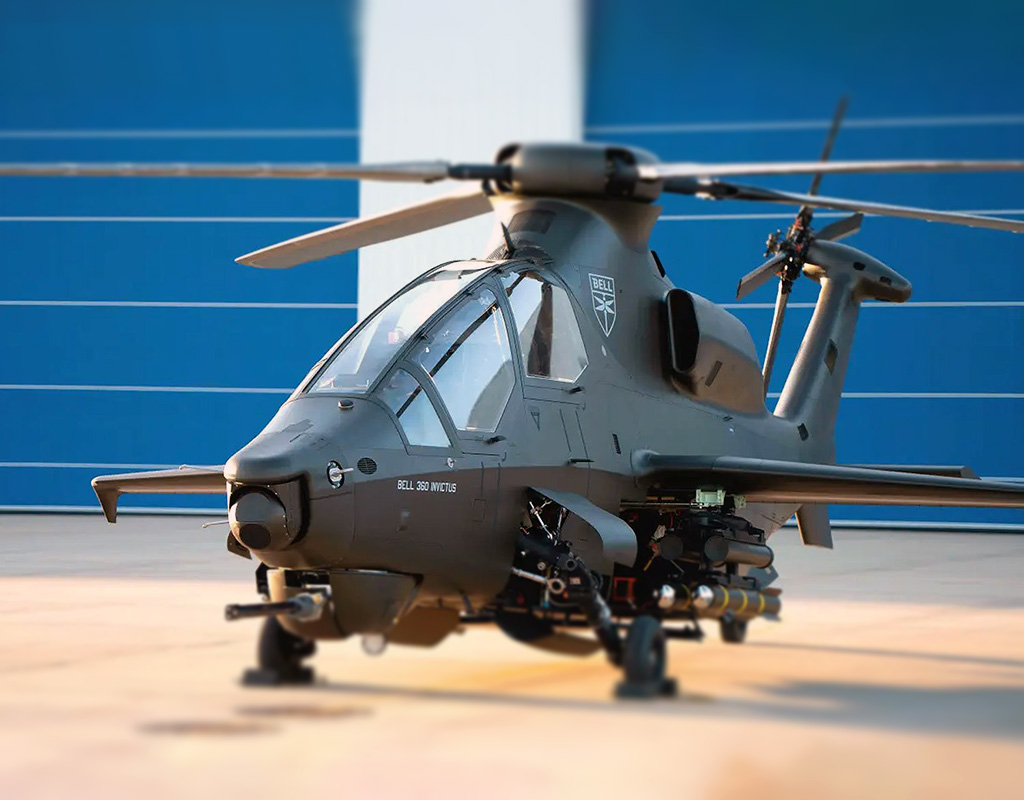
Bell’s 360 Invictus is over 95 percent complete, with the manufacturer anticipating a spring arrival for the type’s General Electric T901 engine and the start of ground runs.
The 360 Invictus is Bell’s candidate for the U.S. Army’s Future Attack Reconnaissance Aircraft (FARA) program, which seeks to fill a “capability gap” the Army has identified for reconnaissance and security missions following the retirement of the Bell OH-58 Kiowa Warrior. The Army has said FARA is its top aviation priority.
As per Army speed requirements, the tandem-cockpit, single-main-rotor 360 Invictus is designed to fly at least 180 knots. Notable elements of the aircraft’s design include short wings, a shrouded main rotor hub, and a canted open tail rotor (switched from a ducted design about halfway through the prototype’s build process).
Bell had previously expected the T901 ITEP (Improved Turbine Engine Program) by November 2022, but is now looking at its arrival “in the spring” said Keith Flail, executive vice president for advanced vertical lift systems at Bell.
“That’s obviously a critical piece for us so that [the 360 program team] can get the engine, get it installed, have all the appropriate airworthiness blessings and certifications . . . so that we can start out doing restrained ground runs,” said Flail. “We’ll go from restrained ground runs, to unrestrained ground runs, to first flight ideally here in 2023.”
Speaking to reporters during a media briefing at Bell’s Flight Research Center in Arlington, Texas — where the 360 competitive prototype recently relocated to after being assembled at Bell’s facility in Amarillo, Texas — Flail said the Army had chosen not pursue the idea of using a substitute engine to allow an early start to the test process.
“We were looking at different engine options, to keep our customer informed of other things that we could do,” he said. “The Army looked at that course of action and chose to stay on the path with the ITEP.”
Meanwhile, the program team continues to “flight test” the 360 digitally in its Systems Integration Lab (SIL), located just a few meters from the prototype in the Flight Research Center.
The SIL consists of a fully-representative cockpit with real controls in what is essentially a fixed-base simulator, connected through flight computers to real hydraulic actuators in a separate room. This allows the program team to test the aircraft’s response to different real-world conditions, as well as providing the ability to insert failures.

Its use for the 360 mirrors the approach used in the development of the V-280 Valor and the commercial 525 Relentless. Flail said the SIL is a “significant differentiator” in terms of Bell’s development process, allowing a rapid progression through flight testing.
Bell is creating separate SILs to support testing and verification for air vehicle and mission systems for the V-280 and 360 programs.
In addition to building the competitive prototype of the 360, Bell is working on an “increment one” version that will include the full weapons system.
“Everything that’s happening with the competitive prototype continues to inform that increment one program, [and] we’re quickly approaching the system requirements review for increment one,” said Flail.
For the increment one program, Bell is teamed with Sierra Nevada, and will perform an open system verification demonstration later this year. In this, Bell and Sierra Nevada must prove that the aircraft is compliant with the U.S. Army’s modular open system approach — which will allow it to bring in new capabilities and address future obsolescence.
Flail said the increment one aircraft will look very similar “in terms of scale and size” to the competitive prototype, and incorporate the lessons learned from the prototype’s design and build process.
The 360 is competing against Sikorsky’s Raider X compound coaxial helicopter for the FARA contract.
In December, Bell was revealed as the winner of the Army’s other major aviation contract — the Future Long-Range Assault Aircraft (FLRAA) program — with its V-280 Valor tiltrotor. It beat the Sikorsky-Boeing Defiant X compound coaxial in that competition, but Sikorsky protested the decision. The Government Accountability Office has until April 7 to rule on the protest.
“We’re making sure that we’re respecting the process as that all continues,” said Flail. “It’s an official ‘stop work,’ so we can’t work on anything related to the weapons contract [in the meantime].”
Bell staff working on the V-280 program have been redistributed to other programs at the manufacturer in the interim. “We’re keeping all the folks here and ready to go, because we don’t know exactly when the protest ruling will happen,” said Flail. “We’ve got to be spring loaded and be ready to move back out again.”

